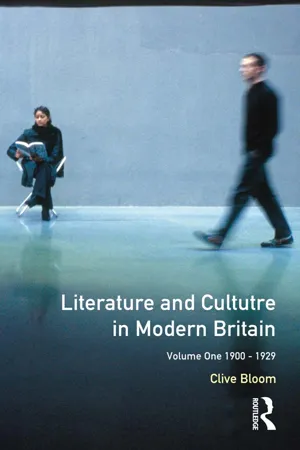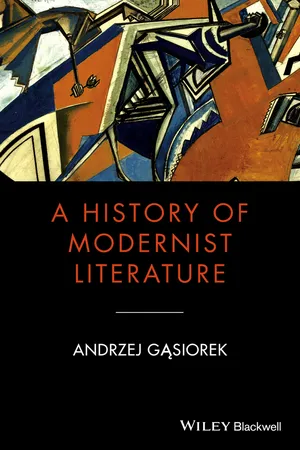Literature
Imagism
Imagism was a modernist movement in poetry that emerged in the early 20th century, emphasizing precise and clear language to create vivid and concrete images. It sought to break away from the flowery and abstract language of the Romantic and Victorian poets, focusing on direct expression and the use of everyday language. Prominent imagist poets include Ezra Pound, H.D., and Amy Lowell.
Written by Perlego with AI-assistance
Related key terms
5 Key excerpts on "Imagism"
- eBook - ePub
- Clive Bloom(Author)
- 2014(Publication Date)
- Routledge(Publisher)
26 Imagism contained three distinct phases. The first was the 1909 group led by T.E. Hulme who, for a year or so, in their weekly meetings in a Soho restaurant, called The Eiffel Tower, discussed the possibility of a new poetic. Then there was Pound’s belligerent school of 1912 and, finally, there were the post- Poundian imagists led by Amy Lowell and dubbed by Pound as ‘Amygists’. As a movement, Imagism could be said to have begun in 1909 and to have died in 1917 when the last imagist anthology was published in Boston.Although Imagism is related to symbolism in its emphasis on form, it differs from it in as much as it seeks to remove the poet from the poem, giving it as objective a character as possible. There was an insistence by poets like Hulme, Flint and Pound that the new poetry should contain no verbiage and should aim for absolutely accurate presentation. In addition, Edward Storer, along with other poets, declared war on the iambic pentameter. ‘There is no absolute virtue in iambic pentameters as such … however well done they may be. There is no immediate virtue in rhythm even … judged by themselves, they are monstrosities of childish virtuosity and needless iteration.’27 The Imagists’ concern for accuracy and economy and the adoption offers libre was a reaction to the sloppy, prolish, meandering and imprecise verse which they felt characterized the state of English poetry.28 Their aim was to revitalize language, to get away from vagueness by means of precise definition.This aim was reflected in a number of highly prescriptive programmes such as Pound’s ‘A Few Don’ts by an Imagiste’ and Flint’s checklist in ‘Imagism’.29 - eBook - ePub
- Tara Mokhtari(Author)
- 2019(Publication Date)
- Bloomsbury Academic(Publisher)
The Imagists formed the first modern poetic movement in 1912, partly as something of a marketing ploy and partly as a revolt against the traditions of the Romantics. Ezra Pound, Richard Aldington, H.D. (Hilda Doolitle), and William Carlos Williams were the founders of Imagism:In the spring or early summer of 1912, “H.D.,” Richard Aldington, and myself decided that we were agreed upon the three following principles:1 Direct treatment of the “thing,” whether subjective or objective.2 To use absolutely no word that does not contribute to the presentation.3 As regarding rhythm: to compose in the sequence of the musical phrase, not in sequence of a metronome.—Ezra Pound3The Imagist rejected poetry which was overly flowery, philosophical, or which described scenes and landscapes at great length (which Pound denounced as a vain attempt of the poet to do the job of a painter4 ). Note that all these features which were so undesirable to the Imagists are common to Romantic poetry. The Imagists wrote in free verse and defined an Image in their manifesto thus: “An Image is that which presents an intellectual and emotional complex in an instant of time.”5The Imagist poets, especially Ezra Pound, took inspiration from Eastern poetic traditions especially the haiku form. One of the most famous Imagist poems “Red Wheel Barrow,” written by William Carlos Williams, almost takes the physical form of a poem written as a set of four connected haikus.Harlem RenaissanceFor more than a decade spanning before and after the 1920s after the First World War migration of great numbers of African Americans from the South to cities like New York, Chicago, and Washington DC, this movement was inspired by new economic and artistic opportunities and celebrated African-American culture, heritage, language, and religiosity. The poets of this movement contravened the pervading white literature and publishing culture of the time to write in styles and on topics which gave a voice to later African-American writers. The scope of influences from which these poets drew ranged from the desire to create something completely new to Anglo-American and English poets to Southern folk music and sermons. - eBook - ePub
- Andrzej Gasiorek(Author)
- 2015(Publication Date)
- Wiley-Blackwell(Publisher)
more avant-garde than their rivals, not less so.) Flint identified three Imagist aims: direct treatment of whatever object the poet was presenting, economy of language, and musical rather than metrical rhythms (this last point conveniently ignoring the metrical nature of much music). These principles were guidelines, not hard-and-fast rules. The first two points implied that Imagists were committed to perceptual immediacy and linguistic thrift, while the third point militated against the regular patterns offered by fixed metres: Imagist poetry was to be structured around loose musical cadences, not governed by rigidly organised beats.Flint noted that the Imagists held ‘a certain “Doctrine of the Image,” which they had not committed to writing’ (IP 129). Pound filled in the gaps in his ‘A Few Don’ts’: ‘An “Image” is that which presents an intellectual and emotional complex in an instant of time’ (IP 130). The basic point was that the poet was trying to capture the truth of a particular perception. The moment of capture was subjective, but it glimpsed a hidden reality, giving ‘that sense of sudden liberation; that sense of freedom from time limits and space limits; that sense of sudden growth, which we experience in the presence of the greatest works of art’ (IP 130). The preface to the second collection, Some Imagist Poets 1915: An Anthology, which included poems by Aldington, H.D., John Gould Fletcher, Amy Lowell, D. H. Lawrence, and Flint (but not Pound), was probably written by Lowell, and it expanded the three main precepts to include ‘the language of common speech’, the creation of ‘new rhythms’, ‘freedom in the choice of subject matter’, the presentation of images, the creation of ‘hard and clear’ poetry, and an insistence on ‘concentration’ (IP 135). It further explained that the emphasis on linguistic precision was a call for truth to the poet’s sensations: ‘The “exact” word does not mean the word which exactly describes the object in itself, it means the “exact” word which brings the effect of that object before the reader as it presented itself to the poet’s mind at the time of writing the poem’ (IP 136–137).61Imagism’s interest in capturing specific moments in time can be seen in several poems. Pound’s three line ‘Ts’ai Chi’h’, which he derived from H. A. Giles’s History of Chinese Literature - eBook - ePub
- Richard Bradford(Author)
- 2005(Publication Date)
- Routledge(Publisher)
Perhaps we should not attempt to establish the ‘correct’ interpretation because Pound’s intention was not to offer us a rational (i.e. grammatical) link between the two images but to recreate the original process by which these images register prior to the imposition of a single post-experiential analysis. Pound’s enthusiasm for the multi-dimensional immediacy of the ideogram is echoed in the ex cathedra writings of his contemporaries. T.E.Hulme called Imagist poetry ‘the new visual art’ consisting of ‘the succession of visual images’. ‘It builds up a plastic image which it hands over to the reader, whereas the old art endeavoured to influence him physically by the hypnotic effect of rhyme’. In practical terms the poetic line should be constructed as a ‘method of recording visual images in distinct lines’. We will later examine a creative manifestation of this thesis in Hulme’s poem ‘Autumn’. There is a constant tension between the creative and interpretive thesis offered by Pound, Fenollosa and Hulme, and the condition of the competent reader: what the former envisage as a snapshot of pre-linguistic experience, uncontaminated by the complexities of conventional linguistic and literary rules, is relocated and normalised by the reader for whom the prerogatives of syntactic cohesion (see Chapter 3, 69–70) are attendant upon our encounters with any pattern of linguistic integers. This problematic relation between literary modernism and the practices and expectations of naturalisation reaches beyond free verse: for example by ‘making sense’ of Joyce’s or Woolf’s use of stream of consciousness are we doing an injustice to their aesthetic intention? The best anthology of early modernist poetic techniques is Jones’s Imagist Poetry (Penguin, 1972). Dip into this and bear the following in mind - Bram Dijkstra(Author)
- 2020(Publication Date)
- Princeton University Press(Publisher)
The step Williams took consisted of a “progression from the concept, the thought, to the poem itself,” just as “the painters following Cézanne began to talk of sheer paint: a picture a matter of pigments upon a piece of cloth stretched on a frame.” It is the making of that step, Williams remarks in the closing pages of his Autobiography, “to come over into the tactile qualities, the words themselves beyond the mere thought expressed that distinguishes the modern, or distinguished the modern of that time from the period before the turn of the century. And it is the reason why painting and the poem became so closely allied at that time. It was the work of the painters following Cézanne and the Impressionists that, critically, opened up the age of Stein, Joyce and a good many others.” 7 The step from the concept to the thing itself, from “feeling to the imaginative object,” from the image as metaphor to the image as subject, was one of the first Williams took on the path which led him away from Imagism and into his lifelong attempt to transpose the visual space and the tensions of painting to the realm of poetry. In Imagist poems the image is usually a metaphor reconstituting an experience in terms of a pictorial equivalent. “These faces in the crowd” are “petals on a wet, black bough.” Thus an Imagist poem, although pictorial in its conception, is essentially a literary fragment, not a unit such as a painting or any other tactile object. It is part of a sequential enumeration of emotive similitudes. If a painter attempts to introduce sequential effects of this kind into his work, the effect is nearly always “literary”: the painting becomes anecdotal, the viewer feels the strain of the narrative content, the “story” takes precedent over the visual construct
Learn about this page
Index pages curate the most relevant extracts from our library of academic textbooks. They’ve been created using an in-house natural language model (NLM), each adding context and meaning to key research topics.




